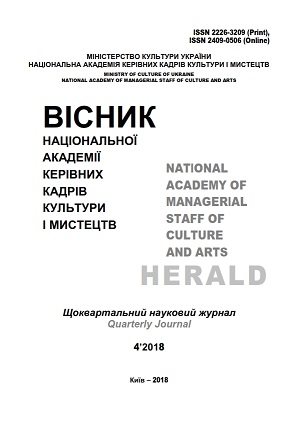Семіотика українського та польського авангарду в світлі ідей Львівсько-Варшавської філософської школи. О. Богомазов – художники «Краківської групи»: від кубізму і футуризму до експресивно-ліричної абстракції (Стаття четверта)
Semiotics of Ukrainian and Polish Avant-Garde in the Light of the Ideas of Lviv-Warsaw Philosophical School. O. Bogomazov - Artists of "Krakow group": from Cubism and Futurism to Expressive and Lyrical Abstraction (Article 4)
Author(s): Volodymyr Anatolyevich LychkovakhSubject(s): Fine Arts / Performing Arts, Semiology, Aesthetics, Contemporary Philosophy, Culture and social structure , Phenomenology
Published by: Національна академія керівних кадрів культури і мистецтв
Keywords: semiotics; homology; artistic imagery; avant-gardism; dialogue of cultures "Ukraine - Poland";
Summary/Abstract: The purpose of the research. In the first article on the semiotics of the Ukrainian and Polish avant-garde, his philosophical aesthetic and cultural context was considered, in particular, in light of the ideas of the Lviv-Warsaw Philosophical School. To continue this problem, the semiotic parallels (homology) in the works of the Ukrainian and Polish avant-gardists of the first third of the XXth century are being analyzed. On the basis of the unity of cultural, aestheticsemiotic and art-study analysis of artistic achievements of artistic avant-gard in Ukraine and Poland, an understanding of the cultural and historical peculiarities of the creative dialogue of artists working in similar ideological and aesthetic paradigms is achieved. Research methodology. The research is based on the aesthetic-semiotic concepts of the representatives of the Lviv-Warsaw School of Philosophy (S. Baley, R. Ingardin, S. Lisse, L. Hvysteck) and the founders of the semantic philosophy of art (K. Bell, B. Croce, S. Langer, G. Rickert) and modern semiotics of culture (Y. Mukarzhovsky, Y. Loman, U. Eko). Interdisciplinary synthesis of philosophical and cultural, aesthetic and art-study approaches is used. Scientific novelty. From the standpoint of modern semiotics, for the first time, symbolic complexes and semantic contents in the works of the Ukrainian and Polish avant-garde are analyzed. Models of semiotic parallels (homologies) are created in the works of leading artists of Ukraine and Poland of the first third of the XX century. The method of extrapolation of the aesthetic-semiotic ideas of the Lviv-Warsaw School of Philosophy is used to understand the similarity and dialogism in the artistic imagery of individual artists. Conclusions. Phenomenological, intuitive, neo-positivist orientations of scientific and artistic and aesthetic thinking have caused cubistic, futuristic, abstract, and constructivist quests of avant-garde artists. The aesthetic principles of the semiosis of avant-guardism in Ukraine were laid by V. Kandinsky, K. Malevich, O. Bogomazov, in Poland - T. Piper, V. Steshinsky, G. Stazhevsky. The development of the Ukrainian and Polish avant-garde of these times is, in particular, a kind of "dialogue" between artistic groups and individual artists in Warsaw and Kiev, Krakow and Lviv. The intellectual atmosphere of these creative "competitions" is symptomatic of the scientific and philosophical positions of the Lviv-Warsaw School of Philosophy with its neo-positivist and phenomenological orientations, and especially - the semantic philosophy of art, which corresponded to the establishment of a new semiosphere of avant-garde imagery. The peculiarities of the dialogue of the artists are analyzed on the examples of aesthetic- semiotic and artistic parallels between V. Kandinsky and Y.T. Pyper (theoretical justification of the avant-garde in art), K. Malevich and V. Stshinsky and G. Stazhevsky (the search for suprematist and constructivist artistic language), O. Bogomazov and artists of the "Krakow group" (the path from Cubism and Futurism to expressive and lyrical abstraction). It is summarized that the semiotics of the Ukrainian and Polish avant-garde of the first third of the 20th century coincides in the sphere of "significant forms" of non-classics in fine arts.
Journal: Вісник Національної академії керівних кадрів культури і мистецтв
- Issue Year: 2018
- Issue No: 4
- Page Range: 36-42
- Page Count: 7
- Language: Ukrainian

